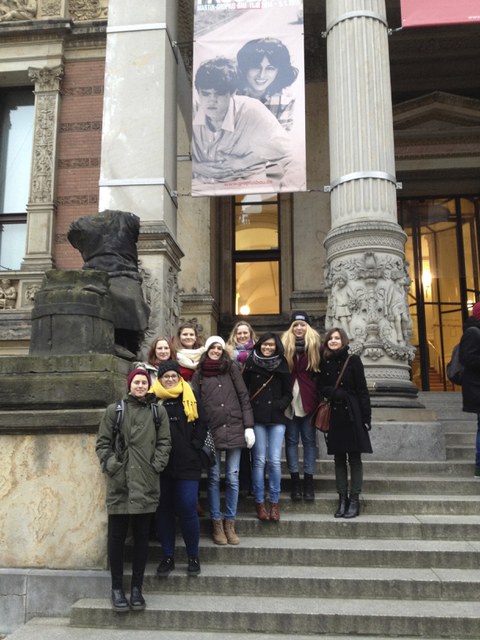Excursion to Berlin to visit the "Pasolini Roma" exhibition (29.11.2014)
In the 2014/15 winter semester, the TU Dresden's Italy Center chose "Rome" as the overarching theme of its events. At the same time, a major exhibition entitled "Pasolini Roma" took place at the Martin-Gropius-Bau in Berlin, which dealt with the Italian writer and filmmaker Pier Paolo Pasolini (1922-1975) and his very special relationship with Rome. It was a fortunate encounter that prompted the organization of an excursion to Berlin for students of the Institute of Romance Studies.
Pasolini was one of the most important Italian intellectuals of the post-war period, constantly searching for new paths and challenges - socially, linguistically, culturally and politically. He began as a poet in his native Friulian language, then in the mid-fifties he published novels in which he used the Roman dialect and portrayed the lives of young hustlers in the Italian capital. During these years in Rome, he came into contact with local filmmaking circles and wrote screenplays for some of the most famous directors of the time, until he became a director himself in the early 1960s. Without being familiar with film techniques, Pasolini invented his own cinematic language, which on the one hand was committed to an immediate reproduction of reality, but on the other was inspired by masterpieces of visual art. Rome and its run-down suburban districts became the central locations of Pasolini's first films: "Accattone" ("Accattone - Wer nie sein Brot mit Tränen aß", 1961) and "Mamma Roma" (1962). The films that followed ranged from further socially critical productions such as "Uccellacci uccellini" (1966), "Teorema" (1968) and "Porcile" (1969) to literary adaptations (see the so-called "Trilogy of Life" with "Decameron" (1971), "I racconti di Canterbury" (1972) and "Il fiore delle mille e una notte" (1974). Pasolini's last, once again dazzling film was to be "Salò o le 120 giornate di Sodoma" ("Salò or The 120 Days of Sodom", 1975), which was released posthumously and once again caused protests, polemics and lawsuits.
Of fundamental importance is, of course, Pasolini's extensive journalistic production, which was particularly critical of Italian society in the 1960s and 1970s: Pasolini provided criticism of the bourgeoisification of society, which resulted in the disappearance of original popular cultures and archaic living environments, and finally, in particular, of the spread of empty conformism, another effect of the lamented social transformation.
Pasolini was murdered on November 2, 1975 under circumstances that have never been fully clarified.
The exhibition "Pasolini Roma" was divided into six sections: It began with Pasolini's arrival in Rome in 1950, where the young intellectual from Casarsa (Friuli) hoped to take refuge from sexual and political intolerance, until his violent death near Ostia on November 2, 1975. The main focus of the exhibition presentations was on Pasolini's life and work in Rome, and in particular the interaction between the urban culture that Pasolini successively explored and his Roman texts and films. The increasingly concentrated focus on the precarious life in the "borgate", the Roman suburban slums, on the everyday culture of the marginalized and outcasts, the hustlers and petty criminals, the "simpler people" on the outskirts of the big city, led to new types of productions with their very own aesthetics, which in turn were able to reshape the image of the city of Rome through the broad, mostly scandalous contemporary reception of Pasolini's works.
Further stops in this extremely informative and successful exhibition were Barcelona, Rome and Paris.
The one-day excursion to view the exhibition, which took place on 29 November 2014 and was attended by eleven Italian Studies students, was organized and accompanied by Italian Studies lecturer Simona Bellini. The partial financing of the train journey and admission tickets was provided by the Institute of Romance Studies, the Italy Center and the Society of Friends and Supporters of TU Dresden.
Exhibition catalogs
Ballò, Jordi (ed.), Pasolini Roma, Milano : Skira, 2014.
Ballò, Jordi (ed.), Pasolini Roma (transl.: Annette Kopetzki), Munich ; London ; New York, NY : Prestel, 2014.
Links
- http://www.pasoliniroma.com/#!/en/index
- http://www.pasoliniroma.com/#!/it/index
- http://www.berlinerfestspiele.de/de/aktuell/festivals/gropiusbau/programm_mgb/veranstaltungsdetail_mgb_ausstellungen_88022.php
- http://www.palazzoesposizioni.it/categorie/mostra-pasolini-roma
Author: Simona Bellini

